Harry Olsen, who is now 97 years old, builds ships.
That was apparent as he sat beside the model of one of the ships he served aboard as a member of the Merchant Marines during World War II. The …
This item is available in full to subscribers.
We have recently launched a new and improved website. To continue reading, you will need to either log into your subscriber account, or purchase a new subscription.
If you are a current print subscriber, you can set up a free website account by clicking here.
Otherwise, click here to view your options for subscribing.
Please log in to continue |
|
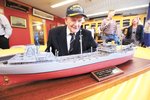
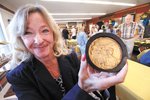
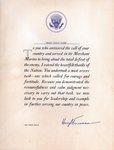
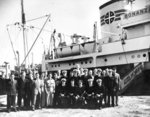
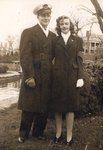
Harry Olsen, who is now 97 years old, builds ships.
That was apparent as he sat beside the model of one of the ships he served aboard as a member of the Merchant Marines during World War II. The model, which Harry built, displays minimal armament and a deck laden with pipes, values and booms. It carried 6 million gallons of aviation fuel, a prime target for Japanese bombers and subs.
But Harry didn’t talk about whatever he feared during his service in the Pacific or Atlantic Theaters at a recent reception honoring him at the Steamship Historical Society of America offices in Warwick.
He is the recipient of a Congressional Gold Medal.
Harry has a vivid recollection of tugs, cargo ships and troop carriers he served aboard, a total of six ships.
The reception, as a staff member of the society pointed out, was as much to focus the spotlight on Harry as it was to bring attention to the Merchant Marines who died in greater percentages than any other branch of the armed forces, yet still had to fight for almost 40 years to gain their veteran status. Harry’s medal was made possible under the Merchant Mariners of World War II Congressional Gold Medal Act of 2020 (HR 5671).
Harry can trace his fascination with boats to when he was six years old. His grandfather put him in a boat and taught him how to row at the Washington Park Yacht Club on Mount Hope Bay. Also as a child when his father was captain of the T.J. Williams a tanker owned by the Standard Oil Company he and his mother would take the train where the boat pulled into port. He would walk the decks and was aboard if the boat had to move within the harbor.
His father was fortunate. He was on sick leave when the T. J. Williams was torpedoed without warning off Iceland in 1941 before United States entered the war.
“I always had boats,” he said in an interview from his home overlooking Apponaug Cove. He owned sail and power boats and teamed up with Bill Shaw, who went on to design boats for Pearson Yachts, to build a class sailing sloop.
Harry would have probably sent most of his life on a boat if it wasn’t for Jackie.
Harry met Jackie skating at Roger Williams Park before joining the Merchant Marines. They remained in contact throughout the war. When he returned home a good deal later than most troops, as he was working on carriers bringing the troops back, he asked Jackie to marry. She agreed but only on condition he didn’t return to the sea.
Harry traveled around the world during the war, having served on boats in the Atlantic, Pacific, Indian Ocean, Red Sea and Mediterranean. Harry lists the ports of call as if reading off a schedule, his memory is that sharp. His boat never came under attack although ships in his convoy were hit.
But there were some harrowing times, if not unusual deployments.
Decoy convoy
Prior to D-Day, the tanker he was aboard was dispatched to New Castle, England, to take on a cargo of slag, a by product of coal mining. A couple of days into to sailing north to Norway they were instructed to return to New Castle. It turns out they were part of a decoy convoy aimed at having the Germans believe the allies were planning to invade from the north.
The irony, says Harry referring to the phrase “it’s like bringing coals to New Castle,” they returned coals to New Castle.
Being at sea was not without some fearful moments. Harry remembers a hurricane that tossed the boat around and had him more anxious than had the enemy been shooting at them. On another occasion while traveling in a convoy in rough seas, the vessel developed a massive crack because of improperly loaded cargo. The crew quickly used winches and cables to pull the steel back in place as best they could, holding the hull tight enough for the ship to leave the convoy and limp back to port.
It was 1943 and Harry was 17 when he enlisted. He started off as a seaman and following training was offered an array of options. Harry was interested in navigation and ended up on the bridge as a quartermaster.
Unlike veterans of military forces, Merchant Marines were not eligible for the GI Bill and the educational opportunities it provided or for other benefits such as housing assistance.
Harry wanted to be an engineer. He went to work for Scott Testers and then a plastics company before landing at Superior Health Care where he climbed to the executive ranks and traveled the world putting together manufacturing agreements. He retired in 1993. His passion for traveling was shared by Jackie. Having visited so much of the world while working for Superior, the couple decided it was time to see this country. They bought a motorhome and visited 37 states and used to travel to Florida. After losing Jackie in 2011, Harry took the entire family to Norway, an adventure he speaks fondly of.
Harry lives alone with family close by. He has an extensive family: three daughters and one son; six grandsons and two granddaughters; three great-great-grandsons and four great-great-granddaughters. He still drives the 1966 Buick Skylark he bought new at the East Greenwich Main Street Garage for $3,0075. He drives an Infinity as his “everyday car.”
“Actually, it was $3,000,” Harry says of the Buick recounting how he went to pick up the car but the dealer wanted to keep it to drive in the St. Patrick’s Day Parade. As an incentive he cut $75 from the price.
“It’s one of the funny things you remember. I had to go to the parade to see my car,” he said. He saw more than that, however. His daughter was also in the parade riding a horse.
Harry is game to do things although he adds, “my mind says to do it and my body is not so willing.” He’s working on a book about his life with his daughter-in-law, Janice Olsen.
As for the 6 million gallons of high octane aviation fuel his tanker was ready to deliver to the Philippines in preparation of the invasion of Japan, there wasn’t room to store it when the war suddenly came to an end. Harry said they “pedaled it” to bases around the world.
Did he ever think of all that fuel he was sitting on top of and what could happen had the boat been hit?
His answer: “I wanted to get it (the delivery) done…I felt it was my duty.”
“I don’t want to be looked at as a hero,” he said in a follow up phone call. “I want to be looked at as a veteran.”
Comments
No comments on this item Please log in to comment by clicking here